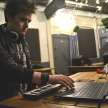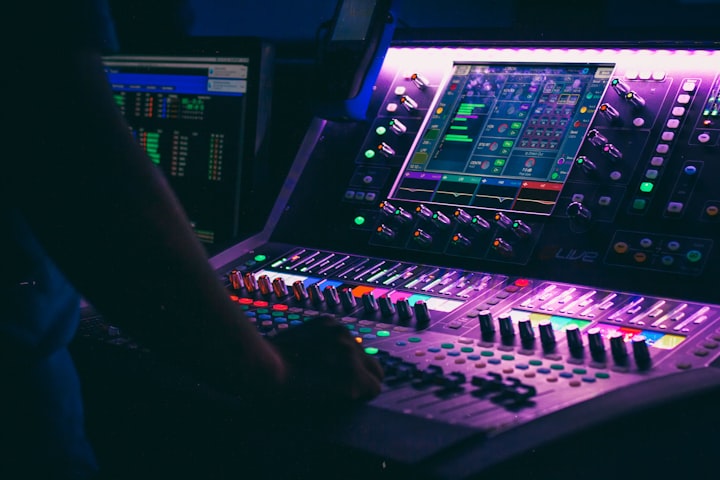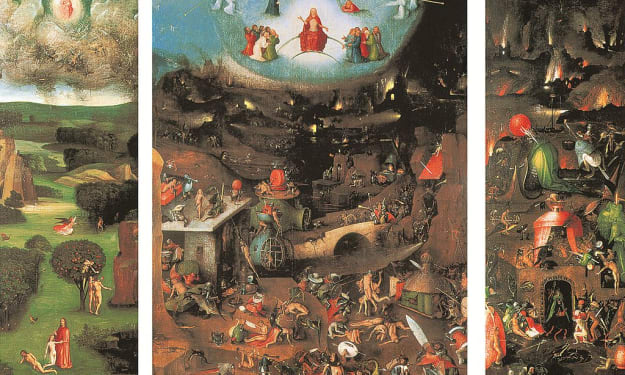An Introduction to Composing Music for Film, TV & Other Visuals
By Jack Corcoran (Jack C. Music)

Contents
Chapter 1 - Introduction
Chapter 2 - Plotting
Chapter 3 - Musical Forces
Chapter 4 - Theory
Chapter 5 - Software
Chapter 6 - Composition Examples
6.1 - Key Composers
6.2 - Key Scores
Chapter 7 - Conclusion
Chapter 8 - References
Chapter 9 - Bibliography
Introduction
When films, TV Shows and Adverts etc. have been recorded, a key post-production step is to compose and arrange music for it. So why is this?
- It helps to further comment on the emotion of the current scene(s) for the audience.
- In some cases, it can enhance every little movement of characters' actions, also known as "coming from a scoring technique that was often used in Mickey Mouse cartoons" (Hoffmann, R.)
- They can create Identities to the plot with the use of themes.
- They can set the scene.
- It can reference the setting's location, social status, and cultural background.
This article aims to show you how scores like these are done, the theory behind them, the key examples and how you can learn to make these as a pastime, or even as a livelihood.
Plotting
In most visual scenes, most composers will start pieces from scratch (sometimes they may choose an existing popular music piece when more appropriate). This means that before they write a single note, they will watch the clip over a few times and make notes based on the graphic content in front of them, which then gives them a chance to subdivide these sections into smaller sections, which makes up the concept of 'Spotting' - A term to describe where what music will go, at what points in a project.
With this text example below, this is how it could be written. Bear in mind there would be images alongside these.
0:27 - Sun sets, Strings are introduced.
0:51 - Plane starts to land, percussion rolls.
1:43 - Train stops, audience applause, brass enters, other instruments quieter.
2:02 - Wartime Speech Read out, Pilot Abandons Plane, long sustained chords and minor, mellow tone.
2:55 - Pilot Taken Hostage, Bass Increases Tempo.
3:58 - Plane catches fire, speech ends, long-lasting major chord to end.
The example scene itself can be found here - https://www.youtube.com/watch?v=KT0BTHkvbto [CREDIT - Christopher Nolan, Warner Bros. Pictures, Dunkirk, 2017].
Musical Forces
Like it is writing any piece of music, many different forces of music are considered. The thing that makes it stand out for visuals, however, is that they are considered with more intricacy and delicacy.
This is based on what is mentioned on the previous chapter, which states that the maturity and awareness of noticing what happens in the scene can be applied to the texture of music that is composed and recorded.
If you are unsure of the list of musical forces, this is a list of them and an easy way to remember them, that I learned of my tutor in A Level (Baccalaureate) Music:
Think Rocky Balboa, in Rocky III, and how M.R. T. H.I.T.S. him:
Melody: The concept of a leading role over all other instruments.
Rhythm: The concept of time within a piece. The tempo being the speed of the piece, and the duration for how long each sound lasts within it.
Tonality: The ranges and pitch of a piece, and instruments in it. How high or low is the average pitch and range? More for Bass or Treble?
Harmony: The other parts other than the melody, designed to accompany that melody in a settled way.
Instrumentation: How many, and what instruments are in the piece? This one varies the most over composing for visual scenes.
Texture: How ornamented and decorated is the composition? are there many counteracting parts being played at once, or very few?
Structure: The way the piece is organised. The most common aside from film music is Intro, Verse, Chorus and Bridge etc., but in film there are usually lettered terms for specific sections, such as binary (A & B, repeat).
Theory
Leading on from the previous Chapter, knowing the ins and outs of those forces is equally as important to and just as lead on by knowing how to break down music theory on a whole.
In terms of for Film, TV and the like, these are what I feel is most important. Be weary that this part is specifically for existing musicians that understand music theory already.
1. Learn your Dynamic (Volume) Terms, what is most relevant to the visual. Is your piece of Crescendo features, Diminuendo (getting louder or quieter)? Is it naturally dominant and forte, so louder than the speech? or does it feel pianissimo, by sitting back behind the original film sounds?
2. Understand what key(s) you want the piece to be in. It is scientifically proven that some keys work much better than others for certain emotions, that can be sparked by the audience, especially if your piece can and does involve a key change. Do not limit yourself to just thinking of the main 12 notes, and be more subjective to what else can be arranged on top of that/
3. Think of how you wish your chord progressions to be made. By this, state first what the chord progressions and melodies are. Chromatic? Diatonic? Conjunct? Dissonant? Then, decide what instruments will share those chordal parts in harmony.
4. Most importantly, decide on the metre of your piece. To ensure that all of this fits well in time to the visual, decide on how many beats per bar are ideal, and how often that timing needs to change, particularly if the events in the scene are happening spontaneously out of sync to standard 4/4 music. After this step, you can then make decisions on steps 1, 2 and 3.
Software
This is the most crucial part if:
- You are new to this subject.
- You want to compose digitally, as opposed to on paper and send off to companies for full arrangements of your scores, in professional usage.
To keep this article relatively brief, here is a quick summary of what you can use to help you do it digitally (in some cases to save time).
- Digital Audio Workstations (e.g. Ableton, Audacity and Logic Pro X). This is for making the notation you have thought of audible so that the creators in charge of the Movie are able to hear your final scores easier. If you're an experienced DAW user reading this, you may disagree with my examples, but each to their own, as this step causes controversy.
- Music Notation Software (e.g. Sibelius and MuseScore). This is for writing out the notation for your director, music director, ensemble and recording artists to see. A more theoretical version of the sounds that will be final.
- Visual Editing Software (e.g. Movie Maker Pro or iMovie). This is usually done by someone else also, but can be done by yourself also for integrating the music within the visual as a demo version.
Composition Examples
Key Composers
Most film composers also diversify their skills into other visual formats as well. The best thing you can do is listen to the compositions within the most iconic composers' pieces, and see what common conventions they do in each piece. What trends do you notice?
Try listening to the following for inspiration, these guys did the same to get to where they are now:
- Hans Zimmer (Dark Knight, Pearl Harbor, Interstellar etc.)
- Klaus Bledt (Pirates of the Caribbean etc.)
- John Williams (Star Wars, Indiana Jones etc.)
- Dave Porter (Breaking Bad etc.)
- Danny Elfman (Edward Scissorhands, The Nightmare Before Christmas etc.)
Key Scores
Similarly to how the composers are listed above, why not have a listen to specific scores likewise? They may also inspire you in a similar way.
- The Magnificent Seven Soundtrack
- E.T. - The Extra Terrestrial Soundtrack
- Yoda's Journey Ends (From 'Star Wars')
- Building the Crate (From 'Chicken Run')
- 2001: A Space Odyssey Soundtrack
- Terminator 2: Judgement Day Scores.
- Here Come The Fuzz (From 'Hot Fuzz')
Conclusion
In summary, becoming a composer doesn't happen overnight; it's more appropriate of a role for some people than others, and vice versa.
Becoming a successful professional composer doesn't happen overnight either, it's something that, if you are passionate about, and are willing to attempt at in trial and error over a long time period, your chances of making some income from it are going to increase.
So learn to read music, learn a new instrument and get out there to start scoring!
References
- George Gtps, 2017, What’s The Best DAW Music Production Software, Really? An Essential Buyers Guide For 2017. Available at: https://www.getthatprosound.com/best-daw-music-production-software/ [Accessed 02/07/2018]
- Hoffman, R. (2011) What is the function of film music?. Director's/Producer's guide to working with a Film Composer, 1(12). Available at: http://www.robin-hoffmann.com/tutorials/guide-to-working-with-a-film-composer/12-what-is-the-function-of-film-music/ [Accessed 01/07/2018]
- Price, D., 2017, Creative - 7 Tools To Write Your Own Sheet Music. Available at: https://www.makeuseof.com/tag/3-tools-to-write-your-own-sheet-music-online/ [Accessed 01/07/2018]
Bibliography
- George Gtps, 2017, What’s The Best DAW Music Production Software, Really? An Essential Buyers Guide For 2017. Available at: https://www.getthatprosound.com/best-daw-music-production-software/ [Accessed 02/07/2018]
- Getting The Score, 2008, A composer's guide to film scoring. The Spotting Session - Definition. Available at: http://gettingthescore.com/index.php/the-spotting-session-definition/ [Accessed 30/06/2018]
- Hoffman, R. (2011) What is the function of film music?. Director's/Producer's guide to working with a Film Composer, 1(12).Available at: http://www.robin-hoffmann.com/tutorials/guide-to-working-with-a-film-composer/12-what-is-the-function-of-film-music/ [Accessed 01/07/2018]
- Price, D., 2017, Creative - 7 Tools To Write Your Own Sheet Music. Available at: https://www.makeuseof.com/tag/3-tools-to-write-your-own-sheet-music-online/ [Accessed 01/07/2018]
- Unknown Author (2018), The Elements of Music [pdf]. Available at: wmich.edu/mus-gened/mus170/RockElements.pdf [Accessed 02/07/2018]
About the Creator
Jack Corky Corcoran
Musician, Composer and Part-time Comedian based in Birmingham, UK. Founder of 'Jack Corcoran Music Composition & Drums'.
Facebook.com/JackCorkyMusic
Twitter - @JackCorky_Music
YouTube - Jack Corky Corcoran
365 - [email protected]






Comments
There are no comments for this story
Be the first to respond and start the conversation.